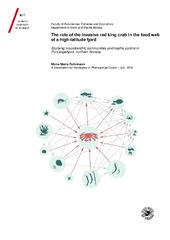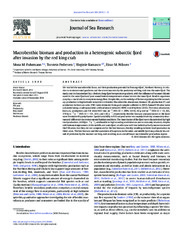| dc.contributor.advisor | Torstein, Pedersen | |
| dc.contributor.author | Fuhrmann, Mona Maria | |
| dc.date.accessioned | 2016-11-17T10:32:06Z | |
| dc.date.available | 2016-11-17T10:32:06Z | |
| dc.date.issued | 2016-11-24 | |
| dc.description.abstract | Biological invasions are a major challenge facing coastal waters and increasingly threaten high-latitude environments. The red king crab is one of the world’s largest decapods and was introduced into the Barents Sea in the 1960s. It has since become a valuable fishery resource in Russian and
Norwegian waters. In the early 2000s, red king crabs entered Porsangerfjord, which now holds one of the largest densities of king crabs along the northern Norwegian coast. This thesis provides new knowledge on how predation by the red king crab may effect benthic community, productivity and the food web in Porsangerfjorden. The major objectives of this thesis were to assess macrobenthic communities and their secondary production in Porsangerfjord, and, together with information on the trophic niche, asses the role of the red king crab in the food web and its predation and competitive impacts through Ecopath with Ecosim mass balance models (EwE).
Benthic communities in Porsangerfjord followed environmental and predation gradients, which affected community traits, such as composition and size structure, resulting in different production and P/B patterns. The red king crab is a generalist, opportunistic predator, feeding on multiple trophic levels. Small and large crabs are likely to affect different habitats and prey species, but took a similar trophic position in the food web. The red king crab played an important role in the Porsangerfjord food web through top-down effects on large, long-lived benthic invertebrate groups by medium and large sized crabs, but had little significance as prey for higher trophic levels and affected mostly the benthic compartment of the food web. Niche overlap and competitive effects with fish species were comparably low, but those may be of significance for birds feeding on benthic invertebrates and for large predatory invertebrates, the latter also being prey for red king crabs. In the future, king crabs may partly replace these invertebrates as major predator in the benthos. Predation pressure by the red king crab may be buffered by high production in some prey, such as polychaetes, but may lead benthic communities to an overall lower biomass and higher turnover system, with unknown consequences for ecosystem stability and resilience. King crabs may help in the regrowth of macroalgae through predation on herbivorous sea urchins, but this needs further investigation and implementation in future models. | en_US |
| dc.description.doctoraltype | ph.d. | en_US |
| dc.description.popularabstract | Denne avhandlingen gir ny kunnskap om hvordan predasjon av kongekrabbe kan påvirke dyresamfunnet på havbunnen og hvilken rolle kongekrabben har i næringsnettet i Porsangerfjorden.
Mål av studien var å undersøke bunndyresamfunnet og produksjon i Porsangerfjord, samle in informasjon om kongekrabbe sin diet og modellere påvirkning på andre arter I økosystemet.
Bentisk produksjon i Porsangerfjorden varierte med endringer i miljøet og i predasjonstrykket. Predasjon av kongekrabbe rammet samfunnets fundamentale egenskaper, som for eksempel samfunnets sammensetning og størrelsesstruktur, noe som resulterte i endringer i biomasse og P/B mønstre i fjorden. Kongekrabbe er en generalist, en opportunistisk predator som beiter på flere trofiske nivåer. Små og store krabber vil sannsynligvis påvirke ulike habitater og byttedyr, men hadde en lignende trofisk posisjon i næringsnettet. Mellomstore og store kongekrabber spilte en viktig rolle i næringsnettet i Porsangerfjorden ved å utøvde top-down press på store, langlevende bentiske dyr. Kongekrabben selv hadde liten betydning som byttedyr for høyere trofiske nivåer, og påvirket derfor mest den bentiske delen av næringsnettet. Nisje overlapp og konkurranse med fiskearter var forholdsvis lav, men disse kan være av betydning for noen fugler som beiter på bunndyr og for store virvelløse rovdyr som også er byttedyr for kongekrabben. I fremtiden kan kongekrabbe delvis erstatte disse virvelløse dyr og innta en posisjon som fremtredende rovdyr i bunndyrsammfunnet. Predasjonstrykket av kongekrabbe kan muligens bli dempet noe gjennom høy produksjon av noen byttedyr, slik som børstemark, men kan føre til en totalt sett lavere biomasse i bunnsamfunnet og en høyere omsetning i det bentiske systemet, med ukjente konsekvenser for stabiliteten og robustheten i økosystemet. Predasjon av kongekrabbe på planteetende kråkeboller kan være gunstig for en gjenvekst av makroalger, men denne hypotesen trenger mer empiriske studier. | en_US |
| dc.description.sponsorship | Univeristy of Tromsø
Institute of Marine Research | en_US |
| dc.description | The papers 2 and 3 of this thesis are not available in Munin. <br>
Paper 2: Fuhrmann, M. M., Pedersen, T., Nilssen, E. M.: “Trophic ecology of the invasive red king crab (Paralithodes camtschaticus) in a native benthic food web”. (Manuscript). <br>
Paper 3: Pedersen, T., Fuhrmann, M. M., Lindstrøm, U., Nilssen, E. M., Ivarjord, T., Ramasco, V., Jørgensen, L. L., Sundet, J. H., Sivertsen, K., Källgren, E., Hjelseth, A-M., Michaelsen, C., Systad, G., Norrbin, F., Svenning, M. A., Bjørge, A., Steen, H., Nilssen, K. T.: «Modelling ecosystem structure and trophic control by the invasive red king crab in Porsangerfjord, northern Norway”. (Manuscript). | en_US |
| dc.identifier.isbn | 978-82-8266-125-6 | |
| dc.identifier.uri | https://hdl.handle.net/10037/9974 | |
| dc.language.iso | eng | en_US |
| dc.publisher | UiT The Arctic University of Norway | en_US |
| dc.publisher | UiT Norges arktiske universitet | en_US |
| dc.rights.accessRights | openAccess | en_US |
| dc.rights.holder | Copyright 2016 The Author(s) | |
| dc.rights.uri | https://creativecommons.org/licenses/by-nc-sa/3.0 | en_US |
| dc.rights | Attribution-NonCommercial-ShareAlike 3.0 Unported (CC BY-NC-SA 3.0) | en_US |
| dc.subject | Invasion biology | en_US |
| dc.subject | Ecopath modelling | en_US |
| dc.subject | Ecology | en_US |
| dc.subject | Macrobenthic communities | en_US |
| dc.subject | VDP::Matematikk og Naturvitenskap: 400::Zoologiske og botaniske fag: 480::Økologi: 488 | en_US |
| dc.subject | VDP::Mathematics and natural science: 400::Zoology and botany: 480::Ecology: 488 | en_US |
| dc.title | The role of the invasive red king crab in the food web of a high-latitude fjord
Studying macrobenthic communities and trophic control in Porsangerfjord, northern Norway | en_US |
| dc.type | Doctoral thesis | en_US |
| dc.type | Doktorgradsavhandling | en_US |


 English
English norsk
norsk

